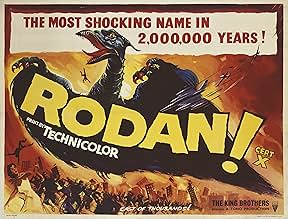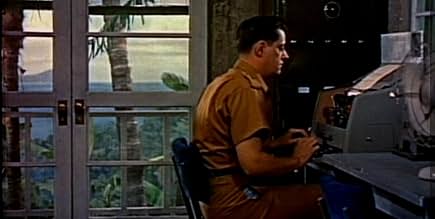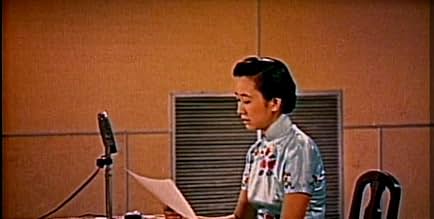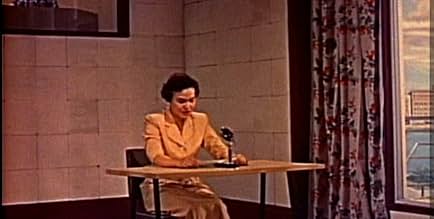AVALIAÇÃO DA IMDb
6,2/10
6,4 mil
SUA AVALIAÇÃO
Adicionar um enredo no seu idiomaA mining engineer investigates the deaths of his colleagues, discovering prehistoric nymphs and a creature capable of flying - and wreaking havoc - at supersonic speeds.A mining engineer investigates the deaths of his colleagues, discovering prehistoric nymphs and a creature capable of flying - and wreaking havoc - at supersonic speeds.A mining engineer investigates the deaths of his colleagues, discovering prehistoric nymphs and a creature capable of flying - and wreaking havoc - at supersonic speeds.
- Direção
- Roteiristas
- Artistas
Kenji Sahara
- Shigeru Kawamura, colliery engineer
- (as Kenji Sawara)
Kiyoharu Onaka
- Male Honeymooner, Sunagawa's friend
- (as Kiyoharu Ohnaka)
Mike Danning
- American Soldier Typing
- (as Mike Daneen)
Tsurue Ichimanji
- Haru, Kiyo's neighbor
- (as Tazue Ichimanji)
Avaliações em destaque
This film is one of the best of the kaiju eigas that Toho ever made. The reason for this is that it is played much like the movie that in a way inspired it, "Them". The way the film begins plays almost like them did, the police and mine workers wondering who, or what, is responsible for the deaths of four men. The tension builds and builds from the first appearance of the giant insects to the destruction of Fukuoka (for some reason called Sasebo in the American version). Even though Rodan the monster did not become as successful as Godzilla, the film is more of a thrill ride and definitely should be hailed as a great science fiction film.
So the other night I watched a film that I had not seen more than once since I was a kid, the 1956 Japanese classic "Rodan." I had seen this movie at NYC's Film Forum around 25+ years back but had very little recollection of it still. And what a fun film it is, as I was reminded again just recently. In it, miners in a small Japanese village are being killed off by a mysterious something, and that something turns out to be giant bugs that have hatched deep underground. But the community's problems grow even worse when two prehistoric eggs in the mine shaft suddenly burst open, to reveal two monstrous flying reptile creatures, which promptly do what all self-respecting Japanese kaiju do in situations like this: lay waste to the countryside and a neighboring city! This film was helmed by "Gojira" director Ishiro Honda, of course, and like that earlier film, features awesome FX by the great Eija Tsuburaya and music by Akira Ifukube. The FX range from cheesy (the two rodans look pretty silly) to spectacular (one of the bridges that gets destroyed looks so lifelike that I would swear the producers knocked down an actual bridge in the making of this film). The film's final image, of the two rodans going up in flame near an erupting volcano, choosing death together rather than fighting separately, is actually kind of sweet and lovely. Adding to the fun: the presence of "Gojira"'s Dr. Serizawa himself, actor Akihiko Hirata, minus the eyepatch here. In all, very entertaining stuff, and very nice to reacquaint myself with this childhood favorite again....
Japanese miners are killed by giant prehistoric insects awakened by nuclear testing. After dealing with the bugs, the military discovers an even bigger threat has been awakened by the tests. Yup, it's Rodan, a pterodactyl-like monster that flies at super-sonic speeds. Soon another Rodan shows up and the two wreak havoc. What in the world will Japan do?
Great Japanese giant monster movie with anti-nuke message; a classic of its type. Not on the level of the original Godzilla (or Gojira, if you insist) but better than many of the cheesy sequels that came out later. It's cool that it was filmed in color. The special effects and action scenes are lots of fun. Love the music. It's a good way to pass the time.
Great Japanese giant monster movie with anti-nuke message; a classic of its type. Not on the level of the original Godzilla (or Gojira, if you insist) but better than many of the cheesy sequels that came out later. It's cool that it was filmed in color. The special effects and action scenes are lots of fun. Love the music. It's a good way to pass the time.
"Rodan" was one of the few Japanese monster movie classics that were not only heavily altered for its release into the United States, but was re-edited with respect and care for the original vision of its director Ishiro Honda. As a result, even though the Japanese and English versions are different, both are highly stimulating and tremendously enjoyable monster mashes and it's no surprise why "Rodan" was such a big hit in both countries. This is one of the most purely enjoyable, yet complex and captivating science-fiction films ever made and also boasts some surprisingly grand special effects sequences, a commendable music score, and fantastic directing by Ishiro Honda.
Rodan, a popular pterodactyl-like monster, had his debut in this 1956 film, although he does not even make an appearance until the movie is nearly over. The picture starts out with a local mining village being placed under attack by giant clawed insects crawling out of the caverns in which they harvest coal for a living. After the prehistoric arthropods brutally slaughter seven people, an investigation is conducted and a more horrifying truth is discovered. Something other than giant bugs may have resurfaced sometime after the testing of the H-bomb and at the same time, an object capable of flying at supersonic speed is spotted attacking aircraft all over the world.
It's the complexity of the story and the plot that I still find really captivating about "Rodan." If it weren't for the title, we would assume that Rodan is not even in the movie at all. We'd think it was about giant bugs. Sort of like a Japanese equivalent of "Them!" the great James Arness flick with giant ants. Rodan does not make a full-fledged appearance until the movie is nearly over and when he does show up, it's with tremendous awe and presence. The fact that Rodan is also created with some surprisingly grand special effects is another key element to his interesting qualities as a movie monster. Instead of plodding through miniature buildings like Godzilla, Rodan whips across the screen with dazzling speed and produces hurricane winds and shock waves to devastate his foes and victims. The audio track is pumped up with earsplitting shrieks as Rodan breaks the sound barrier and his trademark cry here is really a very disturbing and spine-tingling noise. Sequences such as Rodan attacking a plane (inspired by the infamous Thomas F. Mantell UFO incident) and fighting jets in a supersonic dogfight are truly exhilarating. Furthermore, we've got a cast of characters who are worth caring about. The great Japanese actor Kenji Sahara plays the titular role of Shigeru Kawamura, one of the miners who stumbles upon one horrifying event after another. And he has connections with the other characters, most notably with Yumi Shirakawa. Their relationship and chemistry is almost as fascinating as the monsters.
When the movie was distributed into the United States, like with the first Godzilla pictures, changes were made. Unlike however with that film, the changes here were more considerate and honorable. As long as you can forgive the hammy, sometimes irritating narration by Keye Luke, you can respect the distributors' decisions such as improving editing changes and addition or re-arrangement of musical cues. As an overall movie, the Japanese version feels more complete, more wholesome, and is a better picture. But its English counterpart is very nearly on par with its kinetic energy and confidence.
The cast is in terrific shape. Kenji Sahara is a truly talented actor and those who say otherwise (that no Japanese monster movie can have good acting) just look at his expression as he tries to overcome amnesia and try to say that again with a straight face. Yumi Shirakawa is also terrific as his love interest, Akhiko Hirata is once again convincing and commendable as the obligatory scientist wanting to learn the truth, and Akio Korobi not only has the physical appearance of a police chief, but plays one with presence.
"Rodan" is an unfortunately overlooked monster movie masterpiece. Most people who know it are only so because the Rodan character would later become affiliated with the Godzilla franchise. Now that the original Japanese version has been nicely given a DVD release in the U.S., I hope people can truly appreciate how great this genuinely spectacular science-fiction classic is. It is complex, well-written, drawn-out, and the ending of the picture is surprisingly moving.
Rodan, a popular pterodactyl-like monster, had his debut in this 1956 film, although he does not even make an appearance until the movie is nearly over. The picture starts out with a local mining village being placed under attack by giant clawed insects crawling out of the caverns in which they harvest coal for a living. After the prehistoric arthropods brutally slaughter seven people, an investigation is conducted and a more horrifying truth is discovered. Something other than giant bugs may have resurfaced sometime after the testing of the H-bomb and at the same time, an object capable of flying at supersonic speed is spotted attacking aircraft all over the world.
It's the complexity of the story and the plot that I still find really captivating about "Rodan." If it weren't for the title, we would assume that Rodan is not even in the movie at all. We'd think it was about giant bugs. Sort of like a Japanese equivalent of "Them!" the great James Arness flick with giant ants. Rodan does not make a full-fledged appearance until the movie is nearly over and when he does show up, it's with tremendous awe and presence. The fact that Rodan is also created with some surprisingly grand special effects is another key element to his interesting qualities as a movie monster. Instead of plodding through miniature buildings like Godzilla, Rodan whips across the screen with dazzling speed and produces hurricane winds and shock waves to devastate his foes and victims. The audio track is pumped up with earsplitting shrieks as Rodan breaks the sound barrier and his trademark cry here is really a very disturbing and spine-tingling noise. Sequences such as Rodan attacking a plane (inspired by the infamous Thomas F. Mantell UFO incident) and fighting jets in a supersonic dogfight are truly exhilarating. Furthermore, we've got a cast of characters who are worth caring about. The great Japanese actor Kenji Sahara plays the titular role of Shigeru Kawamura, one of the miners who stumbles upon one horrifying event after another. And he has connections with the other characters, most notably with Yumi Shirakawa. Their relationship and chemistry is almost as fascinating as the monsters.
When the movie was distributed into the United States, like with the first Godzilla pictures, changes were made. Unlike however with that film, the changes here were more considerate and honorable. As long as you can forgive the hammy, sometimes irritating narration by Keye Luke, you can respect the distributors' decisions such as improving editing changes and addition or re-arrangement of musical cues. As an overall movie, the Japanese version feels more complete, more wholesome, and is a better picture. But its English counterpart is very nearly on par with its kinetic energy and confidence.
The cast is in terrific shape. Kenji Sahara is a truly talented actor and those who say otherwise (that no Japanese monster movie can have good acting) just look at his expression as he tries to overcome amnesia and try to say that again with a straight face. Yumi Shirakawa is also terrific as his love interest, Akhiko Hirata is once again convincing and commendable as the obligatory scientist wanting to learn the truth, and Akio Korobi not only has the physical appearance of a police chief, but plays one with presence.
"Rodan" is an unfortunately overlooked monster movie masterpiece. Most people who know it are only so because the Rodan character would later become affiliated with the Godzilla franchise. Now that the original Japanese version has been nicely given a DVD release in the U.S., I hope people can truly appreciate how great this genuinely spectacular science-fiction classic is. It is complex, well-written, drawn-out, and the ending of the picture is surprisingly moving.
Ishiro Honda directed this film, which starts off in a small Japanese mining community beset by mysterious killings and disappearances that turn out to be caused by giant insects who are later found to be sealed up in a cavern with Rodan, a giant flying prehistoric bird/lizard that escapes, then attacks Japan(still recovering from Godzilla!) It proves difficult to kill, and as it turns out, isn't alone, and has an egg it's guarding to boot... First film appearance of Rodan(and it's only solo film) has an imaginative opening sequence with the mine subplot, though picks up when Rodan finally appears, even though it's just an airborne version of Godzilla. The surviving Rodan would make return appearances in the Godzilla series, starting with "Ghidorah, The Three-Headed Monster".
Você sabia?
- CuriosidadesThe cable supporting Rodan over Sasebo Bridge snapped, causing suit actor Haruo Nakajima to fall 25 feet into the water. The incident is left in the movie as the scene where Rodan dives into the water near the bridge and submerges. The cables were re-attached for the scene where Rodan lifts off out of the water, but they almost broke again because the suit became waterlogged and doubled in weight.
- Erros de gravaçãoThe opening title says "Rodan © COPYRIGHT MCMXXX1V TOHO CO. LTD." This 1956 film was not copyrighted in 1934.
- Citações
Professor Kyuichiro Kashiwagi (biology): Judging from a piece of its eggshell that we discovered, this one, which we've named Rodan, has a wingspan of 270 feet and weights over 100 tons.
- Cenas durante ou pós-créditosIn the U.S. version, special effects director Eiji Tsuburaya's name is misspelled "Eiji Tsuburya."
- Versões alternativasIn the original Japanese version, there is no dialogue prior to Rodan's attack on the two honeymooners. The American version later added dialogue in which the young woman was joking about her husband taking pictures of the volcano rather than her. Also, in the original version the scene plays a little longer with Rodan making a pass above the couple, with his shadow passing over them, before he swoops in to carry the couple off.
- ConexõesEdited into Valley of the Dragons (1961)
Principais escolhas
Faça login para avaliar e ver a lista de recomendações personalizadas
- How long is Rodan?Fornecido pela Alexa
Detalhes
Bilheteria
- Faturamento bruto nos EUA e Canadá
- US$ 500.000
- Fim de semana de estreia nos EUA e Canadá
- US$ 500.000
- 6 de ago. de 1957
- Tempo de duração1 hora 22 minutos
- Proporção
- 1.37 : 1
Contribua para esta página
Sugerir uma alteração ou adicionar conteúdo ausente

Principal brecha
By what name was Rodan!... O Monstro do Espaço (1956) officially released in India in English?
Responda






















